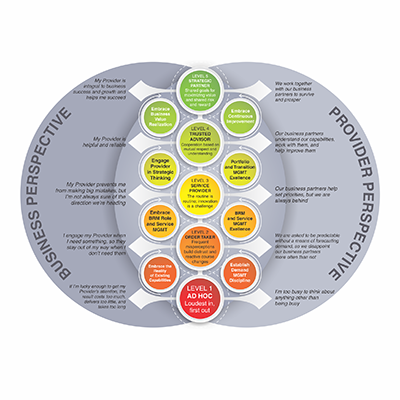How Business Leaders Can Return Value to the BRM

There are many goals to work toward within a developing BRM team, but what is one goal that IT executives truly see as a game changer with the value of their BRMs?
Put yourself in the shoes of the CIO and executive IT leadership. They see presentation after presentation from IT leaders, each one showing why their department is important to fund or keep. Most leaders keep a deck ready to demonstrate how they produce value and why they’re needed—and of course, some are more “creative” than others in their justification.
The executives then sift through this information with questions and details to effectively rank and prioritize projects, departments, and strategies. When it comes to determining where limited budget dollars should go, what sways executives in favor of BRM?
PowerPoint presentations don’t win IT leaders over—corporate is good at making those. What catches the attention of IT executives are business leaders speaking up for their BRMs.
We often talk about how the BRM can add value to the business leader, but what about having the business leader adding value to the BRM? When business leaders speak passionately to IT leaders about the positive impact business relationship management makes to their initiatives, IT pays attention.
- Begin with a vision and goal of a key business leader speaking passionately to your senior IT leadership on the importance of the BRM role toward their objectives.
- Next, grow the relationship to grow the potential. This will take some time, but you already have a roadmap to achieve this: the BRM Maturity Model. At Level 4, “Trusted Advisor,” you’re close. When you step up to Level 5 as a business peer and strategic partner, you now have the full potential to have your business leader speak happily to IT leaders on the value of BRM. Combine this with training and mentorship from BRM Institute and you are ready to go.
- Lastly, make it happen. Once you achieve this potential within the business relationship, a great next step is to ask your manager to invite the business leader as a guest speaker at an executive IT leader meeting to speak about their experience with IT, including BRM. Many IT leaders would be open to the idea of receiving feedback directly from business.
CIOs need to know how much business values BRM, and hearing from them directly is the most impactful way to do this—no filters, biased PowerPoints, or second-hand information involved.
The business leader, on the other hand, can use this to express their satisfaction with the impact of BRM, as well as to ensure that BRM continues supporting them. The value in the business-BRM relationship is not one-sided, so value BRMs produce within business can easily be reciprocated back to the organization as well.
Jim Brusnahan is a Corporate IT BRM for Johnson Controls, Inc., a Fortune 100 company. His background focuses on strategic systems thinking, strategic initiative development and deployment, root cause analysis, and program management. Jim has a degree in Materials Engineering and was a 101st Airborne Infantryman in the U.S. Army. In his free time, he enjoys spending time with his family, doing service work, mentoring, trail running, cooking, reading, and writing.

